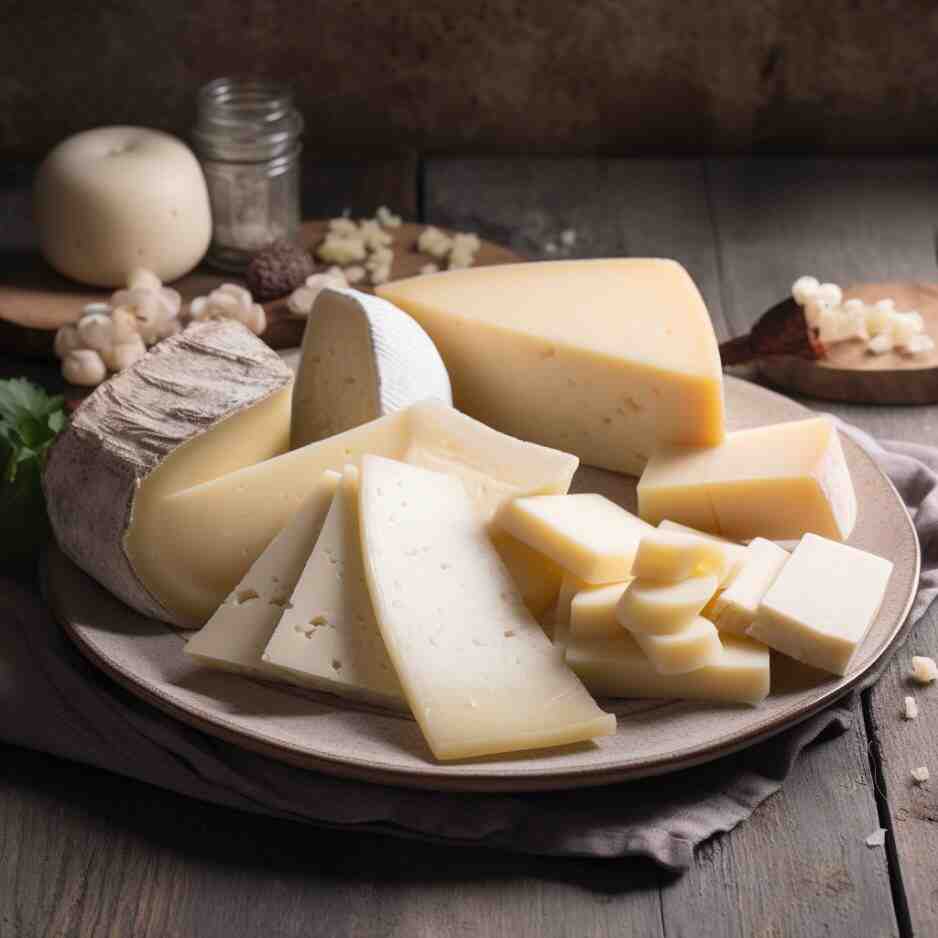
An aromatic, intense, and spicy flavor, Pecorino Romano can be combined with countless dishes.
Obtained from sheep’s milk, Pecorino Romano is one of the few cheeses worldwide that boasts a thousand-year history. The name does not derive from the capital but from history: it was the ideal food for the sustenance of the Roman army. In fact, each legionary was given a portion of bread and spelled soup, accompanied by pecorino cheese.
It is customary to think that pecorino is a purely Roman product, yet 95% of it is produced in Sardinia. The production area of Pecorino Romano is, therefore, Sardinia, Lazio, and some provinces of Grosseto
You’re free to jump directly to our Top Pecorino Cheese Substitutes or continue to read about the main dishes using pecorino.
What is pecorino cheese used for
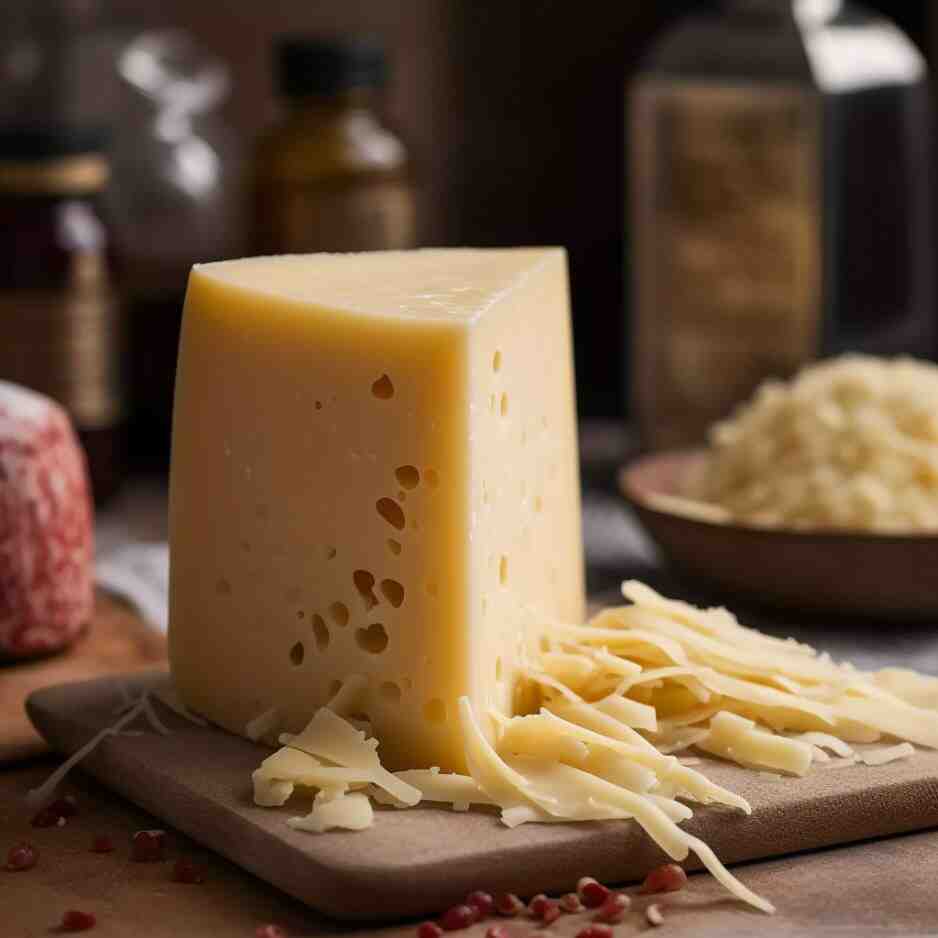
Pecorino cheese is a versatile ingredient that can be used in various recipes. Here are some popular dishes where Pecorino is commonly used:
- Pasta Carbonara: A classic Italian pasta dish made with spaghetti, eggs, pancetta or bacon, black pepper, and Pecorino cheese. The Pecorino adds a salty and savory note to the creamy sauce.
- Spaghetti Cacio e Pepe: A simple yet delicious pasta dish made with spaghetti, Pecorino cheese, black pepper, and sometimes a bit of pasta water to create a creamy sauce. It’s a classic Roman dish that highlights the flavor of Pecorino
- Pesto: While the traditional recipe calls for Parmesan cheese, some variations of pesto use Pecorino instead. Pecorino adds a sharp and slightly salty taste to the basil, garlic, pine nuts, and olive oil mixture.
- Eggplant Parmesan: Pecorino can be used in the breadcrumb mixture that coats the eggplant slices in this popular Italian-American dish. It adds a distinctive flavor when combined with other cheeses like mozzarella and Parmesan.
- Saltimbocca alla Romana: This Roman specialty features thinly pounded veal cutlets topped with prosciutto and sage leaves, then cooked in a white wine and butter sauce. Pecorino Romano is often sprinkled on top to add a salty and savory note.
- Puntarelle Salad: Puntarelle is a type of chicory that is popular in Italian cuisine. In Rome, it is often served as a salad dressed with an anchovy-based dressing and topped with shaved Pecorino Romano for a tangy and salty element.
- Pecorino Romano Risotto: Pecorino Romano can be incorporated into risotto to add a robust and savory flavor. It pairs well with ingredients like mushrooms, asparagus, or zucchini to create a delicious and creamy dish.
- Carciofi alla Romana: This traditional Roman artichoke dish involves stuffing whole artichokes with garlic, parsley, and Pecorino Romano, then cooking them in a combination of olive oil and water until tender.
Top 8 Pecorino Cheese Substitutes Quick Summary
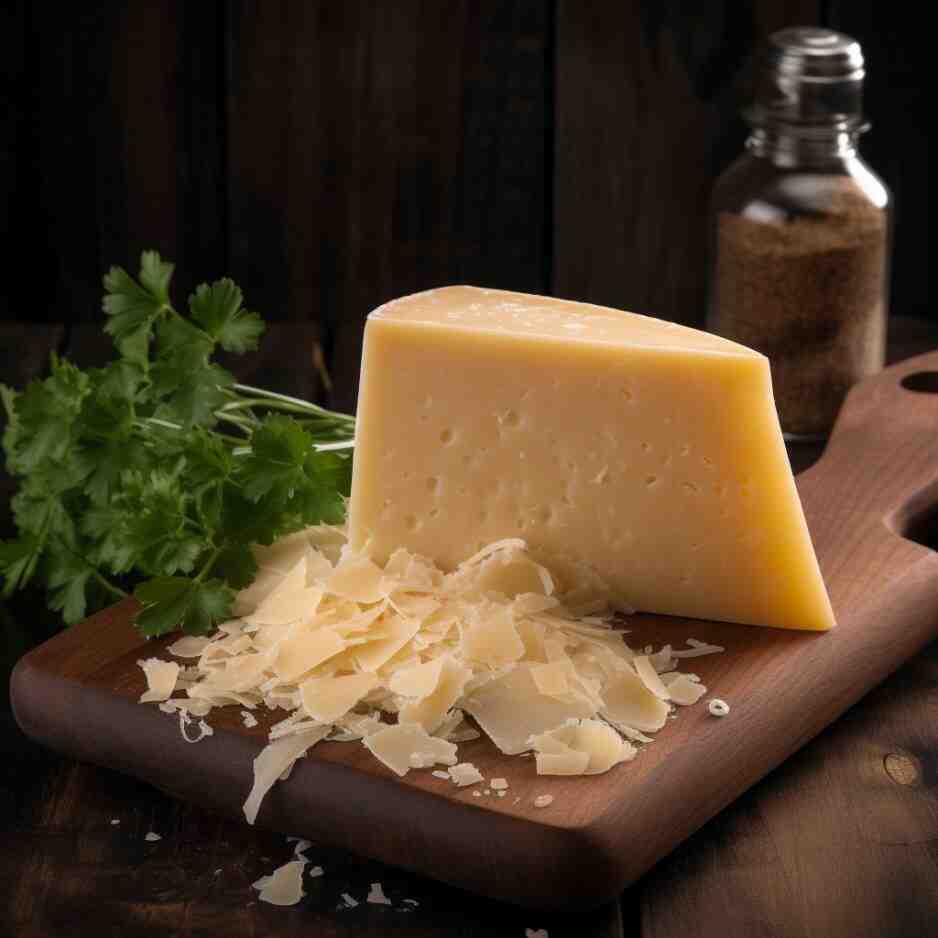
| ✓ | Parmesan cheese, particularly aged Parmigiano-Reggiano, has a similar sharp and salty flavor profile to Pecorino Romano. It can provide a rich umami taste to dishes and works well as a topping or ingredient in various recipes. |
| ✗ | While Parmesan cheese can be a suitable substitute, it has a milder flavor compared to Pecorino Romano. It may lack the distinct tanginess and sheep’s milk flavor of Pecorino Romano. |
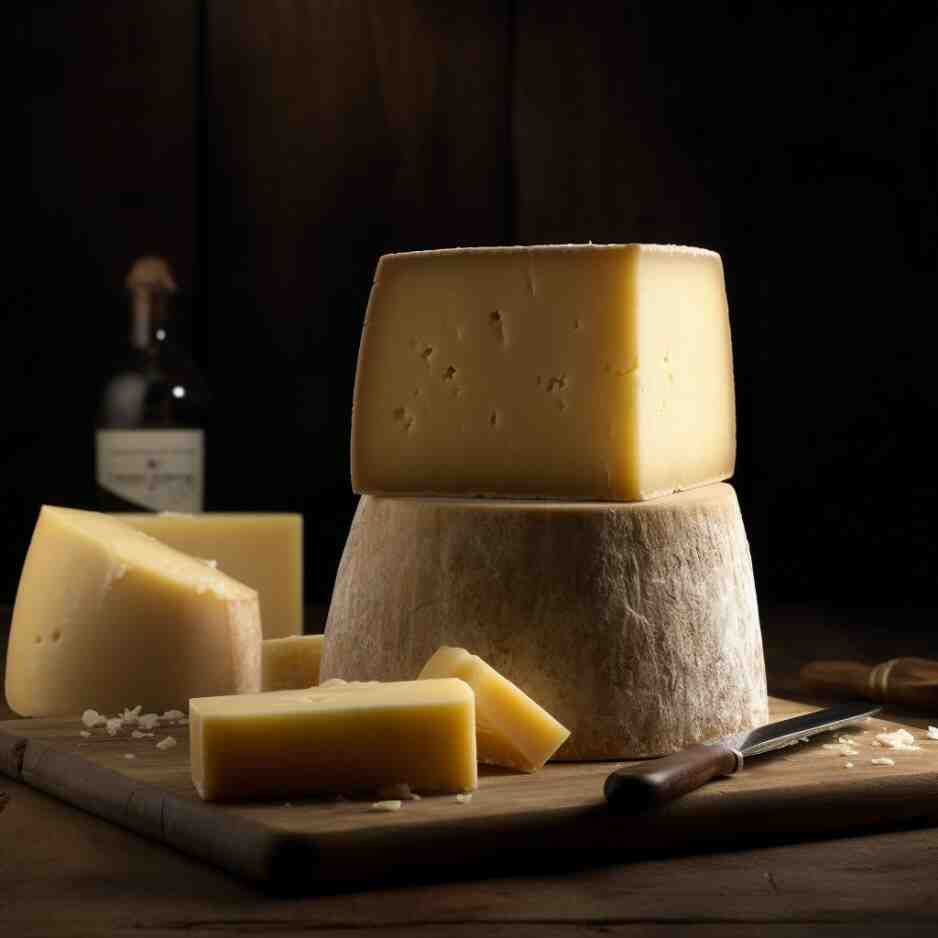
| ✓ | Grana Padano is another Italian hard cheese with a similar texture to Parmesan. It has a nutty and slightly sweet flavor that can complement dishes as a substitute for Pecorino Romano. |
| ✗ | Like Parmesan, Grana Padano may not have the exact tanginess and unique taste of Pecorino Romano. It is a milder option but can still provide a pleasant cheesy element to recipes. |
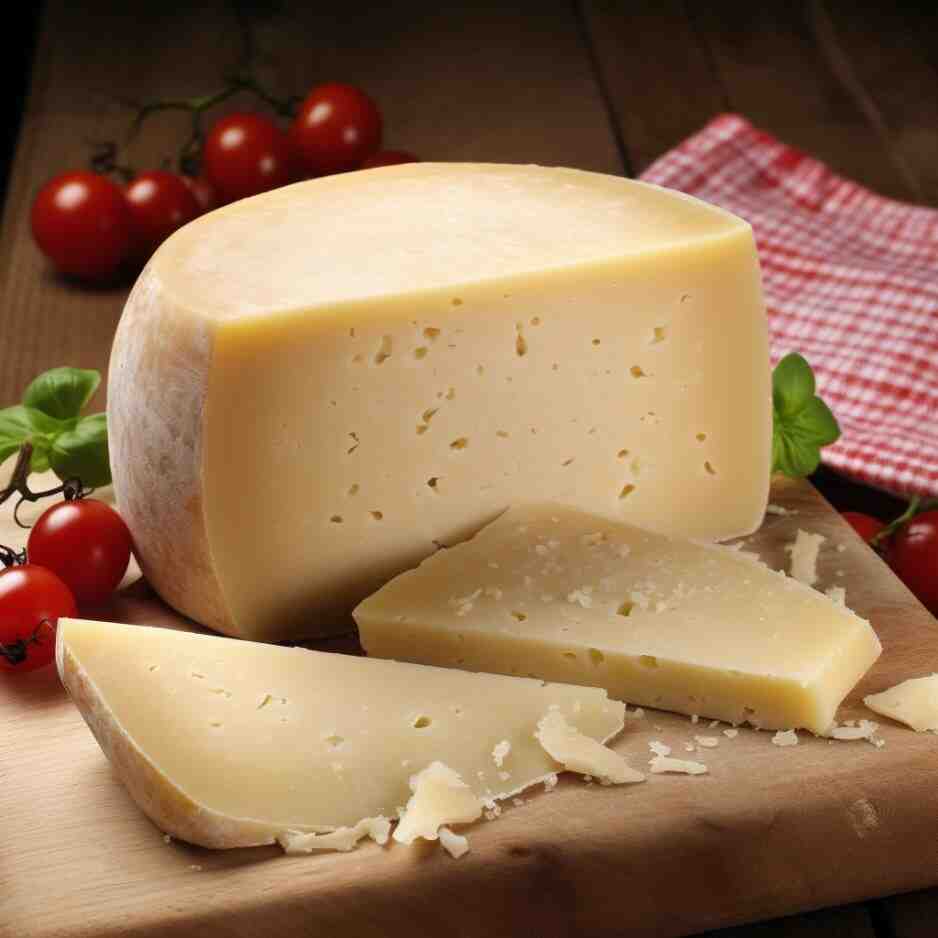
| ✓ | Asiago cheese, particularly the aged version, offers a slightly sharp and nutty taste that can be reminiscent of Pecorino Romano. It can work well in pasta dishes, risotto, and salads. |
| ✗ | While Asiago cheese has its own distinct flavor, it may not replicate the specific tanginess and saltiness found in Pecorino Romano. It is important to consider the flavor profile of the dish when using Asiago as a substitute. |
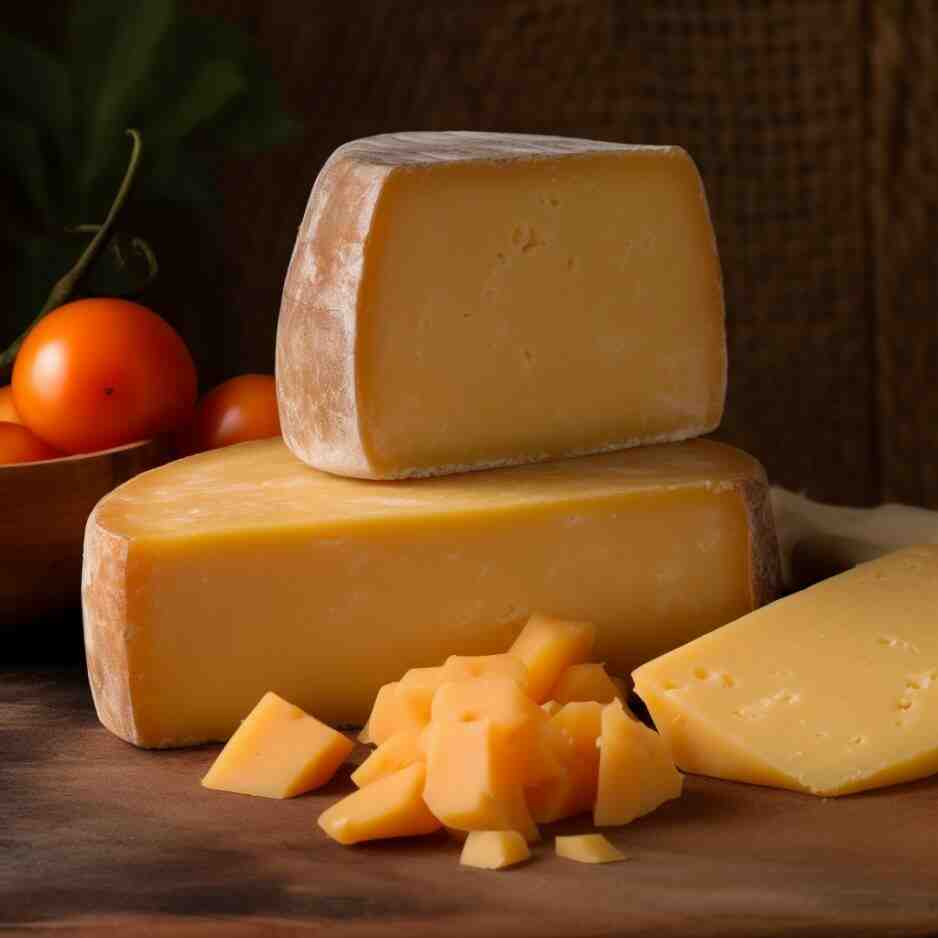
| ✓ | Manchego cheese, a Spanish cheese made from sheep’s milk, has a similar texture to Pecorino Romano and a mild, nutty flavor. It can provide a unique twist to recipes. |
| ✗ | Manchego cheese has a different flavor profile than Pecorino Romano, so it may not fully replicate the taste. It is best suited for recipes where the distinct flavor of Manchego can complement the dish. |
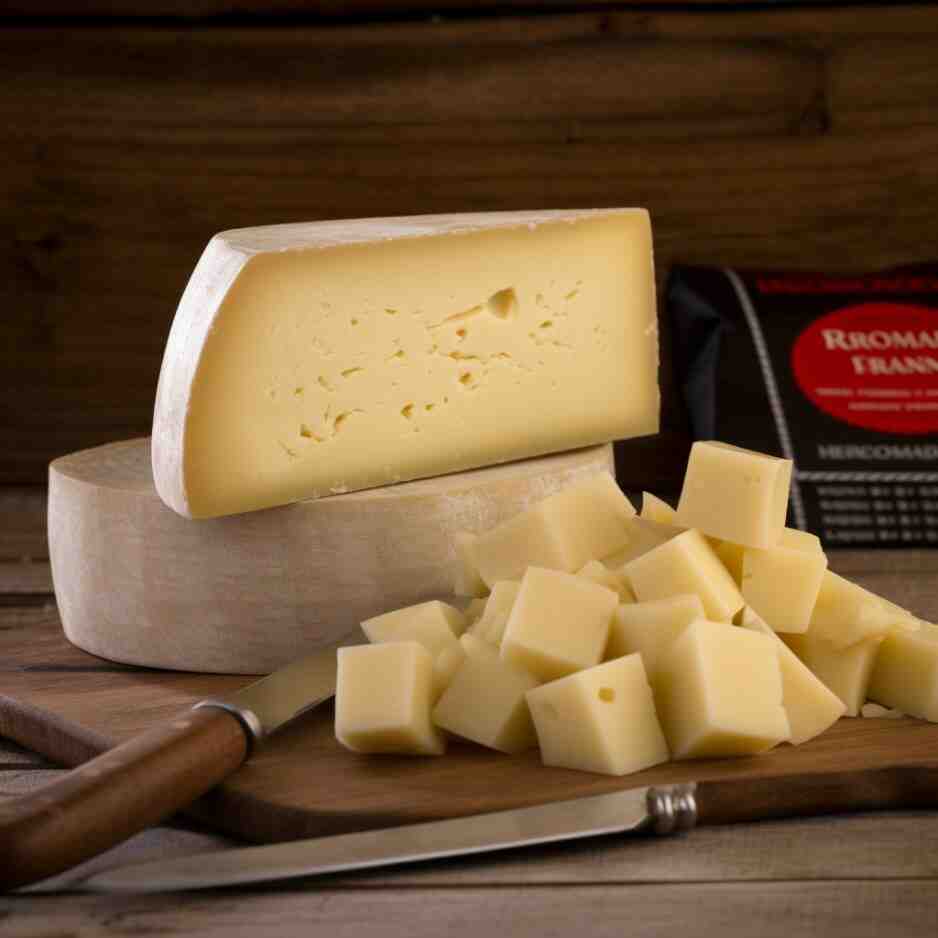
| ✓ | Romano cheese, often made from cow’s milk, has a similar name and flavor profile to Pecorino Romano. It has a sharp and salty taste that can work well in pasta dishes, salads, and sauces. |
| ✗ | While Romano cheese can be a close substitute, it may lack the distinct sheep’s milk tanginess of Pecorino Romano. It is important to choose the appropriate variety, such as Pecorino Romano-style or domestic Romano, depending on availability and desired taste. |
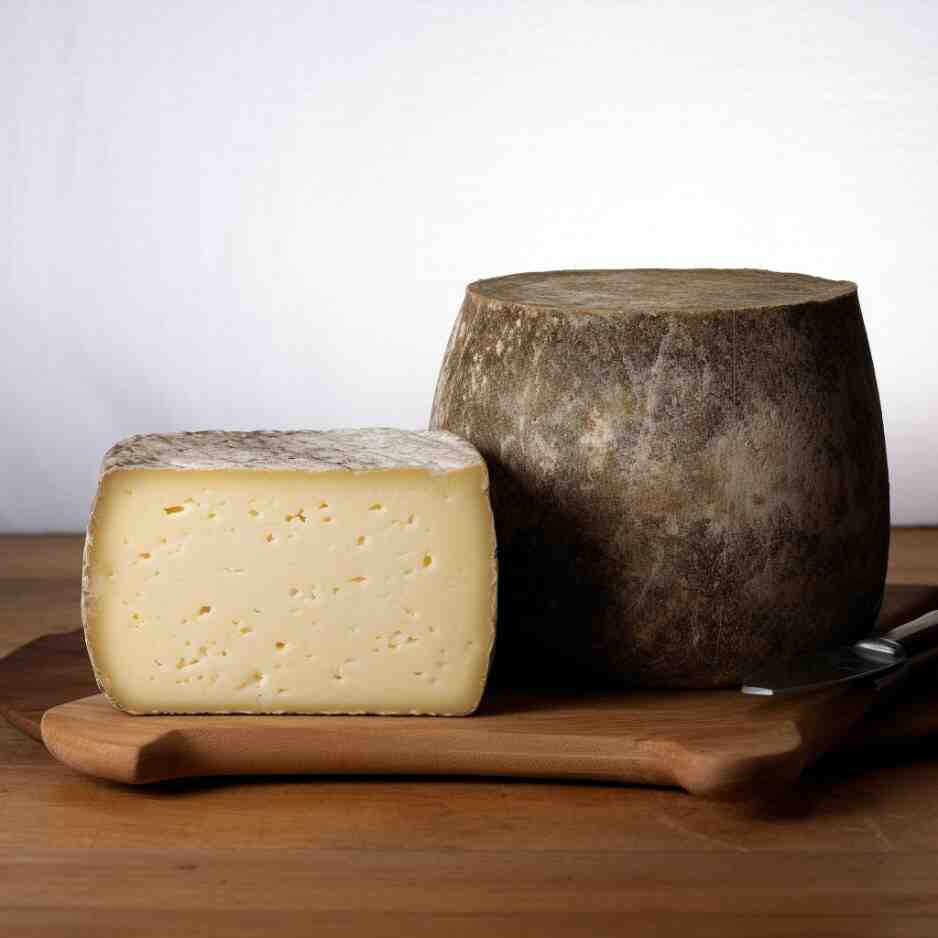
| ✓ | Sardinian pecorino cheese, another Italian cheese made from sheep’s milk, shares some similarities with Pecorino Romano. It has a rich and tangy flavor that can be a suitable alternative in various recipes. |
| ✗ | Sardinian pecorino cheese may not be as widely available as other substitutes, and its flavor can vary depending on the aging process. It’s important to taste and adjust the quantity to achieve the desired level of tanginess. |
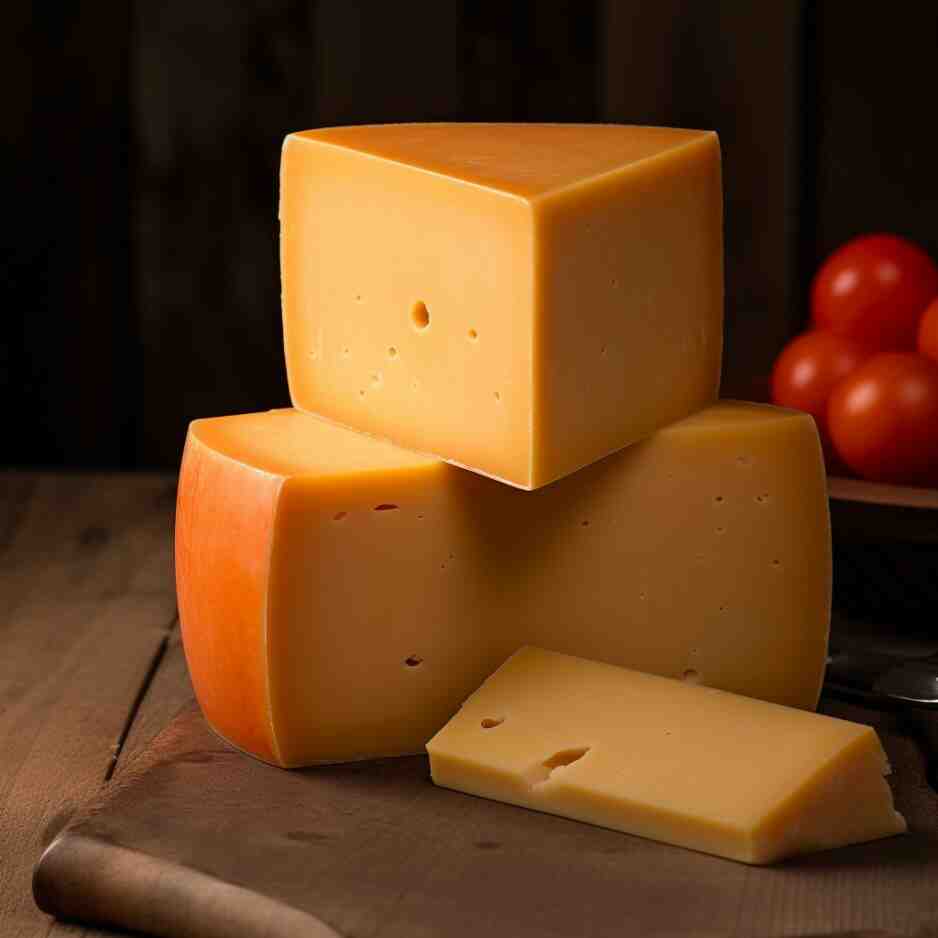
| ✓ | Gouda cheese, a Dutch cheese known for its smooth texture, can offer a mild and creamy taste that works well as a substitute for Pecorino Romano in certain dishes. It melts nicely and can be used in gratins, sandwiches, and cheese plates. |
| ✗ | Gouda cheese has a milder flavor compared to Pecorino Romano, so it may not provide the same sharpness and saltiness. Consider pairing it with other flavorful ingredients to compensate for the milder taste. |
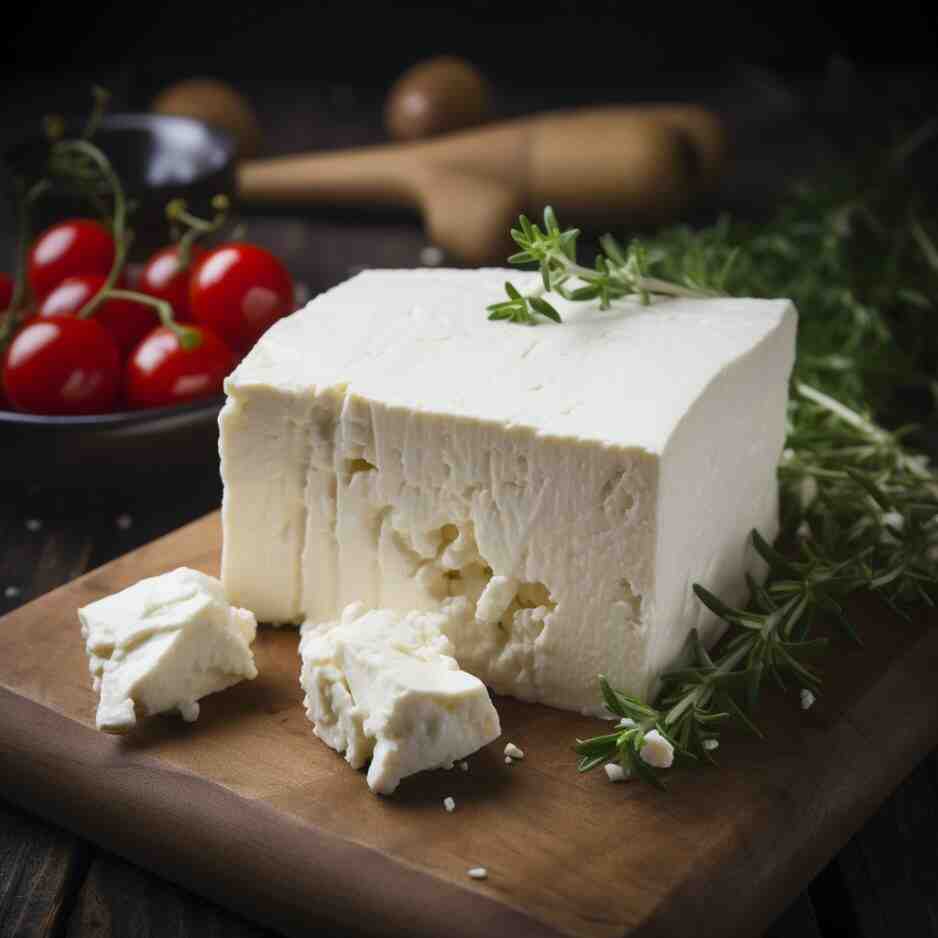
| ✓ | Feta cheese, made from sheep’s or goat’s milk, has a tangy and salty flavor that can add a distinct taste to dishes. While not identical to Pecorino Romano, it can work well in salads, dips, and Mediterranean-inspired recipes. |
| ✗ | Feta cheese has a crumbly texture and a unique tanginess, which may not perfectly mimic the characteristics of Pecorino Romano. Use it in recipes where the briny and tangy elements of feta can complement the dish. |
Best Substitutes for Pecorino Romano Cheese
1. PARMESAN CHEESE

Parmesan cheese is a widely recognized Italian cheese known for its sharp and nutty flavor. Made from cow’s milk, it has a firm texture and is often aged for added complexity. It serves as a popular substitute for Pecorino Romano cheese due to its similar salty profile and texture.
Note: While Parmesan is a great substitute for Pecorino Romano, it is important to note that it is made from cow’s milk instead of sheep’s milk. This difference in milk source may result in a slight variation in flavor and texture compared to Pecorino Romano.
Substitute for pecorino cheese in carbonara, Caesar salad, pesto sauce, and frittatas
Parmesan cheese is the top substitute for Pecorino Romano due to its similarity in taste and versatility in various recipes. It is widely available and can provide a comparable experience when the sheep’s milk flavor of Pecorino is desired. Parmesan cheese can be used as a substitute for Pecorino Romano in various dishes, including pasta carbonara, Caesar salad, pesto sauce, roasted vegetables, and frittatas. Its rich and savory flavor pairs well with these recipes, enhancing their taste.
Nutritional Info: Parmesan vs Pecorino
In terms of nutritional properties, Parmesan and Pecorino Romano have similarities. As Both cheeses are high in protein, calcium, and phosphorus. However, Pecorino Romano typically has a higher fat content due to its sheep’s milk base. However, you need to consider that the type of fat in sheep’s milk is totally different than that of cow’s milk making the former easier to be digested.
- Calories: Around 392 kcal for both cheeses
- Protein: Approximately 35 grams in Parmesan vs 28 grams in Pecorino cheese
- Fiber: Negligible
- Fat: About 26 grams in Parmesan vs 32 grams in Pecorino cheese
- Other Nutrients: High in calcium and phosphorus.
2. GRANA PADANO

Grana Padano is an Italian cheese similar to Parmesan, known for its granular texture and nutty flavor. It is made from cow’s milk and is aged for a significant period, resulting in a rich and savory taste. Grana Padano can be a suitable substitute for Pecorino Romano in various recipes.
Note: While Grana Padano is a flavorful cheese, it may not offer the same distinctive tanginess as Pecorino Romano due to the difference in milk source. The taste may be slightly milder in comparison.
Substitute for Pecorino Romano cheese in carbonara, risotto, roasted veg & salads
Grana Padano is a good substitute for Pecorino Romano, especially when seeking a similar hard cheese with nutty undertones. Its availability and flavor make it a practical option in a variety of dishes such as pasta carbonara, risotto, roasted vegetables, and grated over salads. Its granular texture and nutty flavor make it a versatile option in these recipes.
Nutritional Info: Grana Padano vs Pecorino cheese
Grana Padano is similar to Pecorino Romano in terms of nutritional properties, containing high amounts of protein, calcium, and phosphorus. The slight variation may be in the fat content, with Pecorino Romano potentially having a slightly higher fat content due to its sheep’s milk origin.
- Calories: Around 387 kcal in Grana and 392 kcal in Pecorino.
- Protein: Approximately 32 grams in Grana vs 28 grams in Pecorino cheese
- Fiber: Negligible
- Fat: About 27 grams in Grana vs 32 grams in Pecorino cheese
- Other Nutrients: High in calcium and phosphorus.
3. ASIAGO CHEESE
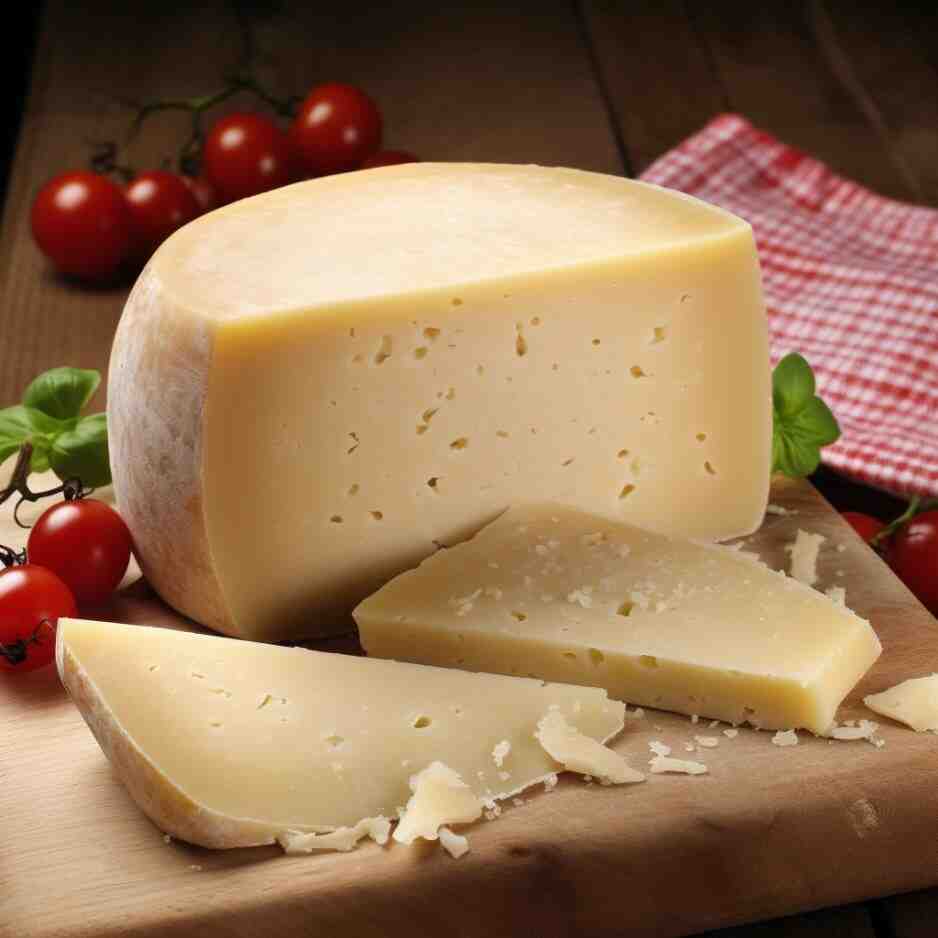
Asiago cheese is an Italian cheese originating from the Asiago plateau in the Veneto region. It comes in two main types: fresh and aged. Fresh Asiago has a mild and delicate flavor, while aged Asiago develops a sharper and more complex taste.
Note: While Asiago can provide a tangy taste, it may lack the distinct saltiness and sheep’s milk flavor found in Pecorino Romano. The flavor profile of Asiago might be milder in comparison.
Substitute for pecorino in pasta primavera, vegetable gratins & salads
Asiago cheese, especially aged Asiago, can be a viable substitute for Pecorino Romano in certain dishes. It is worth considering if a slightly milder tangy flavor is acceptable. Asiago cheese, particularly aged Asiago, can substitute Pecorino Romano in dishes like pasta primavera, vegetable gratins, and salads. Its nutty and tangy flavor can add depth to these recipes.
Nutritional Info: Asiago vs Pecorino Romano
Asiago cheese shares similarities with Pecorino Romano in terms of nutritional value, being a good source of protein, calcium, and phosphorus. However, the fat content may vary slightly depending on the specific type and aging process of Asiago cheese.
- Calories: Around 350 kcal in Asiago and 392 kcal in Pecorino.
- Protein: Approximately 28 grams for both
- Fiber: Negligible
- Fat: About 27 grams in Asiago vs 32 grams in Pecorino cheese
- Other Nutrients: High in calcium and phosphorus.
4. MANCHEGO CHEESE

Manchego cheese is a Spanish cheese made from sheep’s milk and is known for its distinctive flavor and firm texture. It has a slightly buttery and nutty taste, which sets it apart from other substitutes. While not an exact match, Manchego can be used as a substitute for Pecorino Romano in certain recipes.
Note: While Manchego shares the sheep’s milk origin with Pecorino Romano, its flavor profile differs significantly. Manchego has its own distinct taste, and its buttery and nutty characteristics may not perfectly match the tanginess of Pecorino Romano.
Substitute for pecorino in frittatas, savory tards and roasted veg
Manchego can be a substitute for Pecorino Romano when you desire a sheep’s milk cheese, but be aware of the flavor variation. Consider using it in recipes where its buttery and nutty taste can enhance the dish. Manchego cheese can be a suitable substitute in dishes like frittatas, savory tarts, and roasted vegetables. Its unique flavor can complement these recipes and add a touch of richness.
Nutritional Info: Manchego vs Pecorino
Manchego cheese, like Pecorino Romano, offers a good source of protein, calcium, and phosphorus. However, there may be slight differences in fat content and nutritional composition based on the specific variety and aging of Manchego cheese.
- Calories: Around 380 kcal in Manchego and 392 kcal in Pecorino.
- Protein: Approximately 23 grams for Manchego vs 28 grams for Pecorino.
- Fiber: Negligible
- Fat: About 32 grams in M vs 32 grams in Pecorino cheese
- Other Nutrients: High in calcium and phosphorus.
5. ROMANO CHEESE
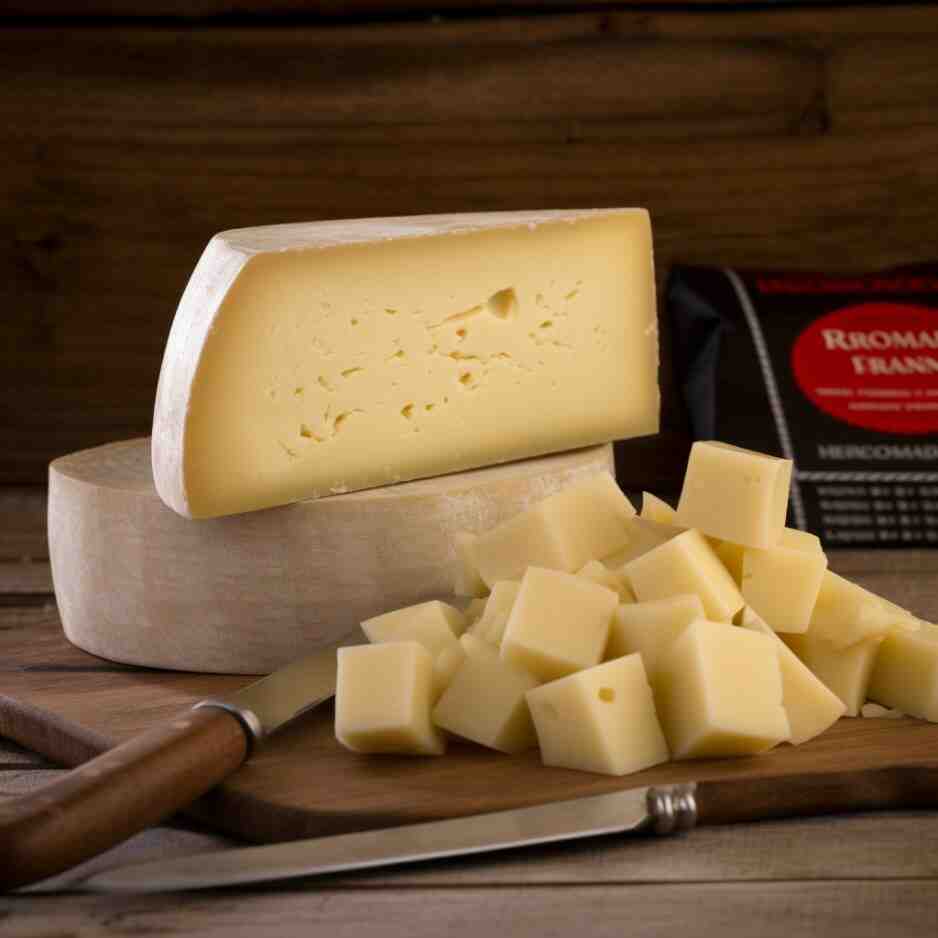
Romano cheese is an Italian cheese made from cow’s milk and is often compared to both Pecorino Romano and Parmesan cheese. It has a sharp and tangy flavor, although it is typically milder than Pecorino Romano. Romano cheese can be grated or shaved and used as a substitute in certain recipes.
Note: While Romano cheese is a suitable substitute for Pecorino Romano, it may have a slightly milder taste. The difference in flavor intensity may be noticeable, especially for those seeking the distinct boldness of Pecorino Romano.
Substitute for pecorino in carbonara, Caesar salad, and roasted veg.
Romano cheese can work as a substitute for Pecorino Romano when a milder flavor is acceptable. Its tanginess can still enhance the overall taste of dishes, although it may not provide the exact same depth of flavor. Romano cheese can be used as a substitute for Pecorino Romano in dishes such as pasta carbonara, Caesar salad, and grated over roasted vegetables. Its sharp flavor can provide a similar tanginess to these recipes.
Nutritional Info: Romano vs Pecorino Romano
Romano cheese is similar to Pecorino Romano and other hard cheeses in terms of nutritional properties. It is typically a good source of protein, calcium, and phosphorus, although there may be slight variations depending on the specific brand.
- Calories: Around 387 kcal in Romano and 392 kcal in Pecorino.
- Protein: Approximately 32 grams for Romano vs 28 grams for Pecorino.
- Fiber: Negligible
- Fat: About 27 grams in Asiago vs 32 grams in Pecorino cheese
- Other Nutrients: High in calcium and phosphorus.
6. SARDINIAN PECORINO CHEESE
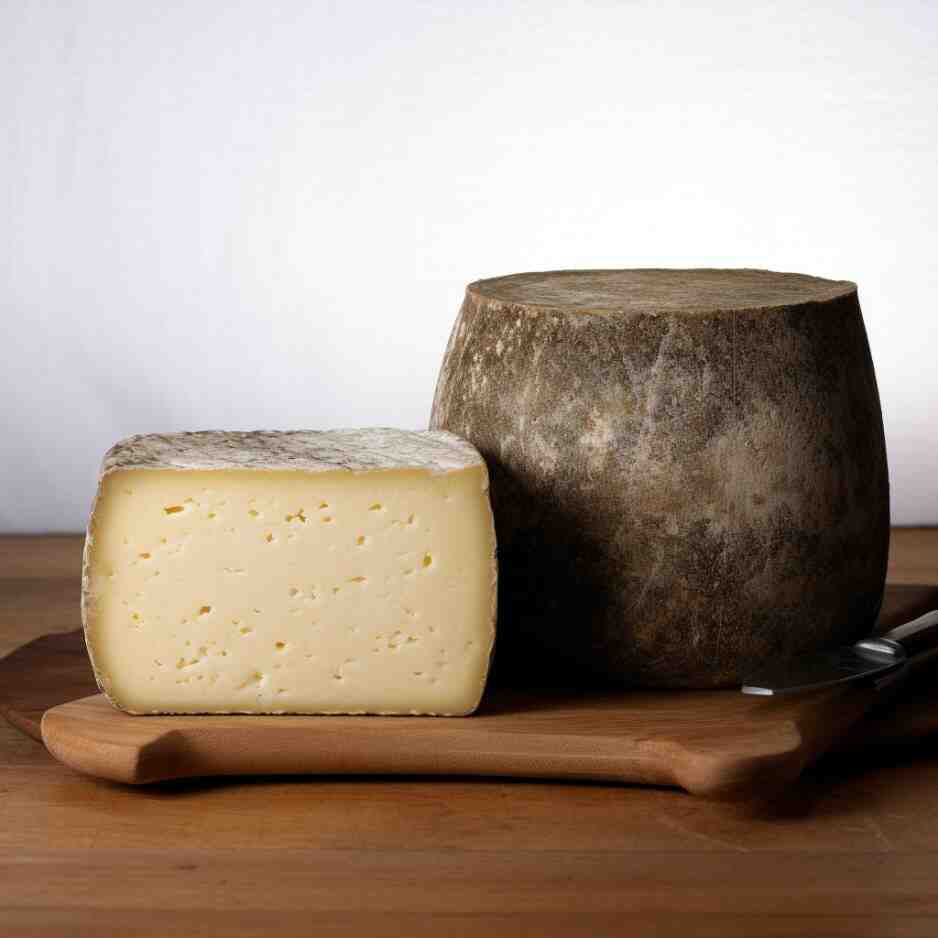
Sardinian Pecorino cheese is an Italian sheep’s milk cheese that also originates from the island of Sardinia. It has a tangy and slightly salty flavor, making it a close relative of Pecorino Romano.
Note: The availability of Sardinian Pecorino cheese may be limited in some areas, making it a bit harder to find compared to other substitutes.
What are the differences between Pecorino Romano and Pecorino Sardo?
Pecorino Sardo is made in Sardinia similar to pecorino Romano where 95% is made on the Sardinian island considered to be the region of sheep. However, pecorino Sardo is slightly less strong since its maturity never exceeds 4 months. Also, the milk used for Pecorino Sardo it is produced only in Sardinia, an obligation that serves to enforce tradition and make the product local.
Substitute for pecorino in pasta sauces, risotto and grilled vegetables
If you have access to Sardinian Pecorino cheese, it can be a great substitute for Pecorino Romano, especially if you prefer or require sheep’s milk cheese. Its tangy and salty nature can be a welcome addition to various dishes. Sardinian Pecorino cheese can substitute Pecorino Romano in various dishes such as pasta sauces, risotto, and grilled vegetables. Its tanginess can add depth and a distinctive sheep’s milk flavor to these recipes.
Nutritional Info: Sardinian Pecorino vs Pecorino
Sardinian Pecorino cheese shares similar nutritional properties to Pecorino Romano, providing a good protein, calcium, and phosphorus source. However, the specific nutritional composition may vary based on the specific brand and aging process.
- Calories: Around 393 kcal in Romano and 392 kcal in Pecorino.
- Protein: Approximately 28 grams for both Sardinian and Romano Pecorino.
- Fiber: Negligible
- Fat: About 32 grams for both Romano and Pecorino cheese
- Other Nutrients: High in calcium and phosphorus.
7. GOUDA CHEESE

Gouda cheese is a Dutch cheese known for its creamy and slightly sweet flavor. It is made from cow’s milk and has a smooth and semi-hard texture. While it differs from Pecorino Romano in terms of origin and flavor, Gouda can still be used as a substitute in certain recipes.
Note: While Gouda cheese can provide a pleasant flavor, it may not offer the same sharpness or tanginess as Pecorino Romano. The difference in taste profile and texture may affect its suitability as a grating cheese in certain recipes.
Substitute for pecorino in pasta sauces, stir-fries, and marinades
Gouda cheese can be used as a substitute for Pecorino Romano when seeking a creamy and slightly sweet cheese presence. Consider using it in recipes where its flavor profile complements the overall dish, but be aware of the variation in taste compared to Pecorino Romano. Gouda cheese can be a suitable substitute for Pecorino Romano in dishes such as sandwiches, cheese boards, and savory tarts. Its creamy and slightly sweet taste can add richness to these recipes.
Nutritional Info: Gouda vs Pecorino Romano
Gouda cheese is similar to Pecorino Romano in terms of being a good source of protein and calcium. However, Gouda typically has a slightly higher fat content compared to Pecorino Romano due to its cow’s milk origin.
- Calories: Around 356 kcal in Romano and 392 kcal in Pecorino.
- Protein: Approximately 25 grams for Romano and 28 grams for Pecorino.
- Fiber: Negligible
- Fat: About 27 grams for both Romano and 32 grams of Pecorino cheese
- Other Nutrients: High in calcium and phosphorus.
8. FETA CHEESE

Feta cheese is a Greek cheese made from sheep’s or goat’s milk and is known for its crumbly texture and tangy taste. While it differs significantly from Pecorino Romano, it can be used as a substitute in certain dishes, particularly in Mediterranean-inspired recipes.
Note: Feta cheese has a distinct flavor profile that is different from Pecorino Romano. Its texture and taste may not offer the same sharpness or depth as Pecorino Romano when used as a grating cheese in pasta dishes or other recipes that require a stronger cheese presence.
Substitute for pecorino in salads, roasted veg, and savory pastries
While Feta cheese can work as a substitute in certain dishes, it may not be the best option if you specifically desire the flavor and texture characteristics of Pecorino Romano. Consider using Feta in recipes where its tangy and crumbly nature complements the overall flavor profile such as salads, roasted vegetables, and savory pastries. Its tangy flavor and crumbly texture can bring a fresh and salty element to these recipes.
Nutritional Info: Feta cheese vs Pecorino
Feta cheese and Pecorino Romano cheese have notable differences in calories, protein, and fat content. Feta has significantly fewer calories and less protein and fat compared to Pecorino Romano.
- Calories: Around 264 kcal in Romano and 392 kcal in Pecorino.
- Protein: Approximately 14 grams for Feta and 28 grams for Pecorino.
- Fiber: Negligible
- Fat: About 21 grams for both Romano and 32 grams of Pecorino cheese
- Other Nutrients: High in calcium and phosphorus.
Conclusion
In conclusion, when seeking a substitute for Pecorino Romano cheese, Parmesan cheese emerges as the top choice due to its similar flavor profile and versatility in various recipes. While other substitutes like Grana Padano, Asiago, and Manchego can also provide viable alternatives, Parmesan cheese offers the closest match in taste and texture, making it the best substitute for Pecorino Romano.
